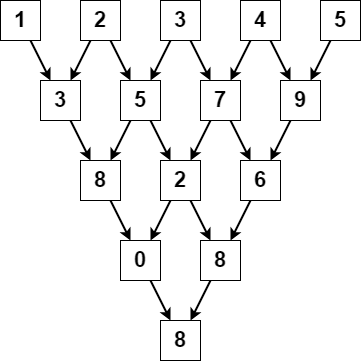- {x}
- Longest Substring of One Repeating Character
- Minimum Health to Beat Game
- Find the Difference of Two Arrays
- Minimum Deletions to Make Array Beautiful
- Find Palindrome With Fixed Length
- Maximum Value of K Coins From Piles
- Maximum Sum Score of Array
- Minimum Bit Flips to Convert Number
- Find Triangular Sum of an Array
- Number of Ways to Select Buildings
- Sum of Scores of Built Strings
- Minimum Number of Operations to Convert Time
- Find Players With Zero or One Losses
- Maximum Candies Allocated to K Children
- Encrypt and Decrypt Strings
- Users With Two Purchases Within Seven Days
- Check if an Array Is Consecutive
- Read More...

Find Triangular Sum of an Array
You are given a 0-indexed integer array nums, where nums[i] is a digit between 0 and 9 (inclusive).
The triangular sum of nums is the value of the only element present in nums after the following process terminates:
- Let
numscomprise ofnelements. Ifn == 1, end the process. Otherwise, create a new 0-indexed integer arraynewNumsof lengthn - 1. - For each index
i, where0 <= i < n - 1, assign the value ofnewNums[i]as(nums[i] + nums[i+1]) % 10, where%denotes modulo operator. - Replace the array
numswithnewNums. - Repeat the entire process starting from step 1.
Return the triangular sum of nums.
Example 1:

Input: nums = [1,2,3,4,5] Output: 8 Explanation: The above diagram depicts the process from which we obtain the triangular sum of the array.
Example 2:
Input: nums = [5] Output: 5 Explanation: Since there is only one element in nums, the triangular sum is the value of that element itself.
Constraints:
1 <= nums.length <= 10000 <= nums[i] <= 9
Solution Explanation: Find Triangular Sum of an Array
This problem asks us to iteratively reduce an array by summing adjacent elements modulo 10 until only one element remains. This final element is the "triangular sum."
Approach: Simulation
The most straightforward approach is to simulate the process directly. We iterate, creating new arrays in each step until only one element is left.
Algorithm:
- Base Case: If the array has only one element, return that element.
- Iteration: Create a new array of size
n-1, wherenis the current array's size. - Summation and Modulo: For each index
ifrom 0 ton-2, calculate(nums[i] + nums[i+1]) % 10and store the result in the new array. - Replacement: Replace the original
numsarray with the newly created array. - Repetition: Repeat steps 1-4 until only one element remains in the array.
- Return: Return the single remaining element.
Time Complexity Analysis:
The outer loop runs n-1 times (where n is the initial array length). The inner loop runs n-1, n-2, ..., 1 times, respectively. This leads to a total number of operations proportional to the sum of integers from 1 to n-1, which is approximately n(n-1)/2. Therefore, the time complexity is O(n²).
Space Complexity Analysis:
In the simulation approach, we create new arrays in each iteration. While this seems to imply O(n²) space complexity, we can optimize it to O(1). Instead of creating new arrays, we can modify the existing array in place. This is achieved by iterating through the array from the beginning and overwriting the elements directly.
Code Implementation (Python)
class Solution:
def triangularSum(self, nums: List[int]) -> int:
n = len(nums)
if n == 1:
return nums[0]
while n > 1:
new_nums = []
for i in range(n - 1):
new_nums.append((nums[i] + nums[i+1]) % 10)
nums = new_nums
n -= 1
return nums[0]
This optimized Python code directly modifies the nums list, achieving a space complexity of O(1) while maintaining the O(n²) time complexity due to the nested loop structure. Other languages would have similar implementations, with only minor syntactic changes. For instance, the Java version would use ArrayList initially and then resize it in each iteration, which could potentially affect space complexity, but this can also be optimized in place to O(1) similar to the above approach.